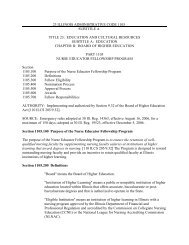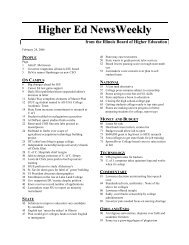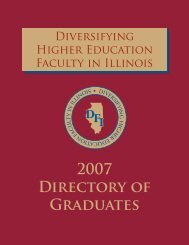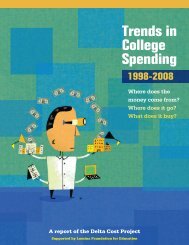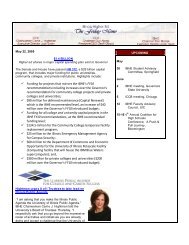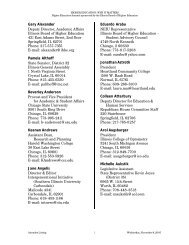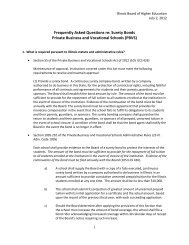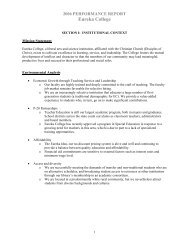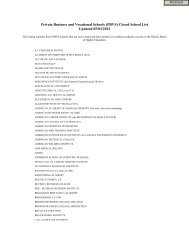A Report on the Feasibility of Textbook Rental - IBHE
A Report on the Feasibility of Textbook Rental - IBHE
A Report on the Feasibility of Textbook Rental - IBHE
Create successful ePaper yourself
Turn your PDF publications into a flip-book with our unique Google optimized e-Paper software.
different printed text, an e-book or custom materials that are actually LESS expensive than anolder versi<strong>on</strong> used for <strong>the</strong> previous adopti<strong>on</strong> cycle.• Page 16, para. 1 – “New editi<strong>on</strong>s close <strong>the</strong> market <strong>on</strong> used textbooks…” – New editi<strong>on</strong>s mayREDUCE demand for an old editi<strong>on</strong> but old editi<strong>on</strong>s are still bought and sold by textbookswholesalers and bookstores, as indicated by this statement from <strong>the</strong> website <strong>of</strong> MBS, <strong>the</strong>country’s largest used textbook dealer: “Old editi<strong>on</strong>s, dropped adopti<strong>on</strong>s, and low-value titlesd<strong>on</strong>'t have to be a nuisance during buyback time. If you're signed up for MBS Custom Buybackand we find late-breaking nati<strong>on</strong>al demand for previously unlisted or "problem" titles, we'll price<strong>the</strong>m accordingly so you d<strong>on</strong>'t have to turn <strong>the</strong>m away.”• Page 16, para 2, lines 4 and 5 – “Zogby Internati<strong>on</strong>al asked students…” -- Replace “students”with FACULTY. “The students resp<strong>on</strong>ded:” Replace “students” with FACULTY.<strong>Textbook</strong> Spending• Page 16, para. 1, lines 3 and 4 – “The Associati<strong>on</strong> <strong>of</strong> American Publishers disputes <strong>the</strong> GAOfigure…” – This is a misquote by a reporter. AAP does not dispute <strong>the</strong> GAO figure, as it iswritten to include textbooks and supplies. AAP’s figure <strong>on</strong>ly accounts for <strong>the</strong> price <strong>of</strong> textbooks– not textbooks and supplies. See Appendix D.• Page 16, para 2 – <strong>IBHE</strong>’s estimated rental costs appear to include <strong>on</strong>ly <strong>the</strong> figures for textbooksand do not include additi<strong>on</strong>al course materials.Used Market, page 18Used textbooks may save students m<strong>on</strong>ey in <strong>the</strong> immediate term but <strong>the</strong>y are not a panacea. In <strong>the</strong> l<strong>on</strong>gerterm, used book sales actually increase <strong>the</strong> cost <strong>of</strong> all textbooks. Two ec<strong>on</strong>omists, Dr. Michael W. Brandl<strong>of</strong> The University <strong>of</strong> Texas at Austin and Dr. M<strong>on</strong>ica E. Hartmann <strong>of</strong> <strong>the</strong> University <strong>of</strong> St. Thomas inMinnesota, have both addressed this topic.Dr. Hartmann, a member <strong>of</strong> <strong>the</strong> Minnesota <strong>Textbook</strong> Task Force, provided <strong>the</strong> following assessment:“The growth <strong>of</strong> <strong>the</strong> used book market, 1 particularly through <strong>the</strong> Internet, and <strong>the</strong> role fixed costsplay in pricing decisi<strong>on</strong>s explain why prices <strong>of</strong> new textbooks are rising and are expected toc<strong>on</strong>tinue rising in <strong>the</strong> future. Publishers <strong>on</strong>ly earn pr<strong>of</strong>it <strong>on</strong> <strong>the</strong> sales <strong>of</strong> new textbooks, not <strong>on</strong> <strong>the</strong>sales <strong>of</strong> used books…The drop in new book sales reduces <strong>the</strong> number <strong>of</strong> book over which apublisher can recover its fixed costs, raising <strong>the</strong> average cost <strong>of</strong> producti<strong>on</strong> and c<strong>on</strong>sequently <strong>the</strong>price <strong>the</strong> publishers must charge to break even or earn some pr<strong>of</strong>it. This is not expected to changein <strong>the</strong> future given <strong>the</strong> popularity <strong>of</strong> used books.” See Appendix E.Dr. Brandl’s comments are from a newspaper column he wrote in 2004:“There is a fallacy <strong>of</strong> compositi<strong>on</strong> at work when college students sell back <strong>the</strong>ir textbooks. Asc<strong>on</strong>tradictory as it may seem, by attempting to save m<strong>on</strong>ey, students are actually helping to pushtextbook prices higher.“Here is how. <strong>Textbook</strong> publishers have fixed costs that <strong>the</strong>y must cover in order to stay inbusiness. Let’s say for <strong>the</strong> sake <strong>of</strong> argument <strong>the</strong>se fixed costs total $50,000. If <strong>the</strong>y sell 1,000textbooks <strong>the</strong> fixed cost part <strong>of</strong> <strong>the</strong> textbook price is $50. Let’s assume <strong>the</strong>y sell 250 textbooks ineach <strong>of</strong> four semesters. The textbook company <strong>the</strong>n sells <strong>the</strong> textbook to <strong>the</strong> bookstore for $60each. Assuming a fairly c<strong>on</strong>servative markup, college bookstores would <strong>the</strong>n sell <strong>the</strong> textbooksto students for $80 each.1 Used book sales account for <strong>on</strong>e-third <strong>of</strong> <strong>the</strong> total textbook sales and this does not even include those books “sold”<strong>on</strong> student run swap sites.-77-



